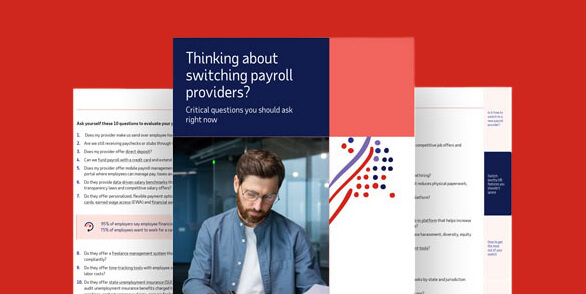Employers are required to pay employees accurately and promptly. When they don’t, their workers may be entitled to back pay. And depending on the circumstances of the underpayment, there’s a risk of a lawsuit or other enforcement action. Understanding back pay and how to address it can help employers manage their risk.
Table of Contents
What does back pay mean?
Back pay is payment for work done in the past where payment was not made at the time work was performed. The employer must make up the difference between what the employees were paid, if they were paid, and what they should have been paid.
How back pay works
When employees are entitled to back pay, their employer must pay them the amounts owed. In some cases, this means simply compensating the employees for the unpaid wages. If the employees file a lawsuit, however, the employer may also have to pay an equal amount in liquidated damages, as well as attorney’s fees and court costs.
Examples of back pay
Back pay can be any form of income that an employee was owed, but did not receive, including:
- Salaries
- Hourly wages (regular or overtime)
- Commissions
- Bonuses
Reasons for back pay
The scenarios in which an employee may be due back pay are many, ranging from honest mistakes to willful attempts to deny someone payment for their work. Here are some of the more common reasons for back pay:
- Worker misclassifications (i.e., classifying employees as independent contractors)
- Wrongful terminations
- Payroll calculation errors
- Retroactive pay increases
- Failure to pay the required minimum wage
- Failure to pay required overtime wages
How back pay is recovered
If employers do not remedy a payment error once it is discovered, they may be required to correct a violation of the Fair Labor Standards Act (FLSA) in one of the following ways:
- The Department of Labor’s Wage and Hour Division may oversee the payment of back wages.
- The Secretary of Labor may file suit for the back wages and an equal amount as liquidated damages.
- The employee may file a private suit for back pay and an equal amount as liquidated damages, in addition to attorney's fees and court costs.
- The Secretary of Labor may obtain an injunction to restrain any person from violating the FLSA, including the unlawful withholding of proper minimum wage and overtime pay.1
Under the FLSA, there is a two-year statute of limitations on back pay recovery, unless the violation was willful, then the statute of limitations is three years. State laws may provide additional remedies and may have a longer statute of limitations.
Addressing back pay requests
Before issuing payment to correct a prior compensation error, employers should review relevant records (i.e., timecards, payroll reports, employment contracts, employee handbooks, etc.) to verify that the employee is eligible for back pay and confirm the amount due. Employers may also want to consult with legal counsel so that any back payments to employees are made in a way that manages their legal exposure.
Manage payroll effectively
Business owners can avoid having to make back payments by processing payroll more accurately. One way to accomplish that is with payroll software that can automate the payroll process. This feature helps employees receive payment on time and eliminates error-prone data entry. Most payroll management systems are also capable of integrating with time tracking tools for superior wage and hour calculation accuracy.
Frequently asked questions about back pay
How do I get back pay?
Employees who believe they are owed back pay usually first try to resolve the issue directly with their employer. Failing that, employees can seek assistance from the U.S. Department of Labor or their state department of labor, or they may file a private lawsuit against the employer (where permitted by law).
When can I get my back pay?
State laws regulate the frequency with which employees must be paid, but in general, employers are required to pay their employees all the wages to which they’re entitled by the next scheduled pay day. If there is a legal dispute regarding the wage claim, payment could be delayed until a resolution is reached.
Is back pay mandatory?
Back pay can be enforceable under federal law, including the FLSA, the Davis-Bacon and Related Acts, and the McNamara-O’Hara Service Contract Act. States may have additional labor laws that address back pay obligations.
When should I ask for back pay?
The FLSA gives employees a two-year period to seek back pay. In cases where the employer willfully withheld wages, the statute of limitations extends to three years. Note, however, that the statute of limitations may be longer under other federal laws and state laws.
Is back pay taxed?
Had employees who were underpaid received the full amount owed to them on their regularly scheduled pay day, it would have been taxed. As such, back pay is subject to the same taxes in the year it is paid.
What is retro pay?
Retroactive pay or “retro pay” is a name used by some payroll systems to describe the process by which employers reimburse employees who were either not paid or underpaid during a previous payroll cycle.
1Back Pay | U.S. Department of Labor (dol.gov)
This article is intended to be used as a starting point in analyzing back pay and is not a comprehensive resource of requirements. It offers practical information concerning the subject matter and is provided with the understanding that ADP is not rendering legal or tax advice or other professional services.






